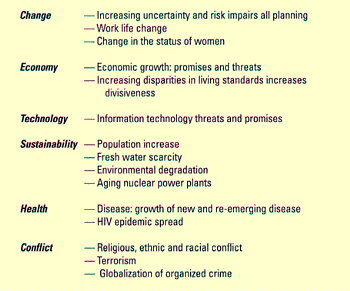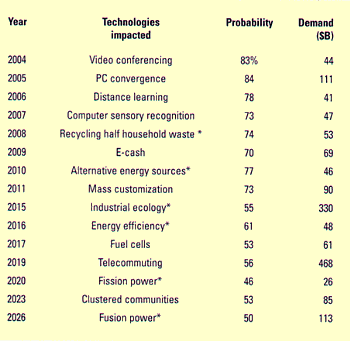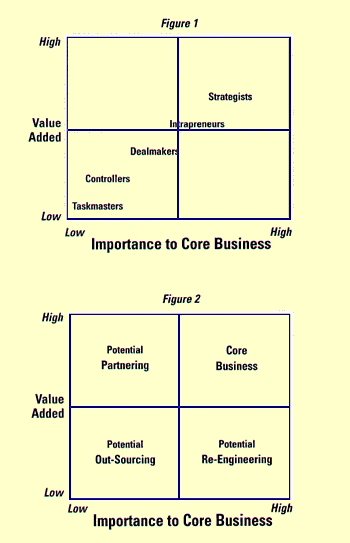From Site Selection magazine, March 1999
M A N A G E M E N T S T R A T E G Y
A futurist charged with leading his firm’s research in the field of facilities management and design for the next century shares his views of which forces will prevail and how corporate real estate will benenfit.
Facilities Management &
Design for the 21st Century
b y R O B B I E C O O K
As we approach the third millennium, the prophets are out in force. To scan the shelves of any bookstore is to be assaulted by exhortations of doom and or glorious futures. With the year 2000 fast approaching, you may have pondered what life will be like during the next century — a difficult question with so many answers. The evolving science of alternative futures studies is beginning to provide answers in the form of systematically determined views of probable alternative futures.

The American Council has conducted an in-depth study of the future of the world for the United Nations University, the Smithsonian Institute and the Futures Group. The Millennium Project, as it is called, is a massive Delphi consensus-building study by a global panel of 200 futurists, scholars and policymakers from 50 countries. It identified 15 primary forces that can be divided into six categories to better relate them to their impact on corporate real estate and facilities design. The categories are listed in the chart (right).
All of these forces will affect corporate real estate facilities design directly or indirectly to some degree. But four categories — change, economy, technology and sustainability — are particularly persuasive and impact corporate facilities more significantly.
 Technology Technology
Of all the forecasts for the future of information technology, none will be more pervasive than Moore’s Law. Moore observed that the memory capacity of computers was doubling every two years, while simultaneously reducing in cost by 50 percent every 18 months. This means that within 10 years we will have unlimited capacity, almost free.
One product of this phenomenon will be development of massive databases that will create a world of “real-time everything.” One of these databases will be an amalgamation of the thousands of separate databases that architects, designers and corporate facilities departments are creating. Eventually, all construction details will be available to everyone on one gigantic database that will have the effect of reducing working drawings from the largest to the smallest part of design services.
George Washington University has completed a comprehensive forecast of technology in a continuous assessment of emerging technologies. The eight-year study identifies 12 fields in a Delphi consensus-building process integrating input from thousands of experts. Every conceivable new development has been systematically prioritized and expressed for its chances for success over the next 25 years, and even forecasts the market demand. Some relevant examples are shown in the chart (right).
Note the gigantic market forecast for mass customization and telecommuting, both of which will directly impact facilities design dramatically. In particular, if telecommuting develops as forecast, the demand for office space will be greatly diminished, but it will be a long time coming. Perhaps even more telling is that the three fields marked with an asterisk are part of the sustainability trend mentioned earlier, giving even more credence to the coming importance of this force. Get ready for it!
Other studies reinforce these views, such as one called “2025: Scenarios of U.S. and Global Society Shaped by Science and Technology,” released in 1997. It identifies 15 scenarios, each dealing with some aspect of society in the year 2025. Although it presents a much more optimistic view, particularly for the US, it generally agrees with the more scientific Delphi studies described above.
Haworth, one of the Big 3 business furniture manufacturers, recently published a study by Dr. Leonard Kruk on the impact of future technology development on workplace design. The publication, “Preparing Today’s Facilities to Support Changing Office Technologies and Work Processes,” identifies technology and changing work environments as the primary forces affecting workplace design. More information is available from the study’s web site, www.haworth.furn.com/kruk.htm
Economy
This is the one force that is mired in extraordinary disagreement. The economists do not have the answers. However, one forecast is very convincing. Harry S. Dent’s “The Great Boom Ahead,” published in 1993, notes that consumer spending comprises 67 percent of the GNP — 80 percent including corporate spending in response to this consumer demand. The Bureau of Labor Statistics tracks consumer spending and has identified an extraordinary pattern. We spend most at age 49. With the baby boomers starting to turn 49 in 1994, Dent’s chart shows a 10- to 15-year growth period carried by baby boomer spending. What is so convincing about this interpretation is that the S&P 500 index, the most reliable indicator of the stock market’s health, shows near-perfect correlation with the demographic line of population of age 49.
Forbes Magazine, in a May 5, 1997, article, puts the ups and downs of the stock market into the perspective of the market’s performance since 1801. Their graph shows that the market only returned to the average trend in 1995. The combination of this long steady trend with the impact of the boomers, reinforced by the burgeoning retirement plans, and the likelihood that some portion of the social security withholding will be invested in the market, suggests that the market will continue to grow for another 10 years. After that, the economy is likely to enter a recession brought on by the passing of the high-spending boomers.
So what? No one can guarantee that we will have a 10- to 15-year growth era, but it is highly likely. No doubt, there will be extenuating forces, such as the current Asian pull on our economy as well as the economic woes in Russia and Japan. In my opinion, the U.S. stock market is well above its average, based on the historical P/E ratio of 15 versus over 20 now. It should correct, but it will rise again, according to Dent’s conclusive theory. You take it from there.
Change
If you think you are being confronted with more and more information, you are right. With the overlapping of the end of the Industrial Era with the beginning of the Electronic Era, there is a multiplication of change as the two compete and duplicate. This “chaotic era of change” is perhaps, the more pervasive force for individuals. Fortunately, there is a universal pattern to all change, whether it is the growth of bacteria in an infection or the sale of a new product. Theodore Modis, a Swiss management scientist, summarizes the copious studies of patterns of change in his book, Predictions, 1994, showing that all change follows a universal pattern of an S curve.
The accelerated role of change and the proliferation of information have led to a malaise of information overload and disorientation. Psychologists have shown that we can avoid being overwhelmed if we categorize all information into patterns of change (see Kathryn Alexandrini’s “Survive Information Overload”, 1993). As a committed futurist, I keep track of information concerning 30 to 40 trends. If any new information agrees with or reinforces an established trend, you can forget it: if it contradicts or adds to a trend, or reinforces an established trend, then I clip it, file it, categorize it as evidence of a possible changing trend. The only antidote to the disorientation that results from information overload, is the opposite — orientation — having a clear vision of long-term purpose and direction.
Real estate executives, facility executives, architects, designers, doctors, lawyers and other professionals traditionally have been educated to be experts that supply solutions to clients– classic supply thinking. With the accelerating rate of change making education increasingly obsolete, only an approach based on demand thinking — thinking in reverse with the need, customer, user and so forth — will help deal with this force of change. Life-long learning is now upon us.
Since most of us work directly or indirectly for corporate America, we need to better understand the demands that forces of change are playing on the principal industries of our economy. Among the hundreds of books on the subject, one stands out in terms of impact of change on corporate America: Dr. Ian Morris’s “The Second Curve”. Morris says the three major industries to be impacted most by change are financial services, retailing and health care.
An extraordinary attempt to relate these forces to the future of interior design was conducted in 1996 by FIDER (Foundation for Interior Design Education Research), the organization responsible for accrediting our schools of interior design. Utilizing the research of several university teams and a focus group of visionaries, including this writer, the study’s primary conclusion makes the same point: a grander, broader vision is the key.
Interior design is uniquely positioned to enhance the quality of life through its central role as the connector between people and places. It’s main challenge is remaining relevant within a world fearing dramatic and rapid social, political, economic, technological and environmental change.
Over 10 years ago, Peter Drucker, a management theorist and writer, said if the railroad industry had envisioned itself as an all-encompassing transportation industry, it would be an airline today. Whatever your vision for life, your company, your work, the built environment, corporate real estate, facilities management, architecture, or workplace design, asking the right question is the start of the solution. Before you read my vision of the future of facilities management and design, write down your version.

The best advice around for career planning and the antidote for job obsolescence was given by Tom Peters in “PostScript of Liberation Management,” 1994. The first task is to educate yourself in at least two disciplines to counter the risk of obsolescence inherent in specialization, he writes. Next, leave the country for at least a year, preferably two, to counter the ethnocentricity that is natural to us all. Learn to see things in a broader context and from a different perspective.
Cesar Chekijian, head of corporate real estate at Chase Manhattan Bank, suggests changing from supply thinking (all professionals are trained in this) to demand thinking of problem solvers. Bruce Russell, formerly head of corporate real estate at Eastman Kodak and a former president of the International Development Research Council (currently heading IA’s re-engineering task force) gave the best advice for real estate and facility executives at an IDRC World Congress four years ago: add value and/or enhance the importance of your job to the core business, illustrated in Figure 1 (above right). The five key responsibilities of the CRE-FM executive identified in IDRC’s Corporate Real Estate 2000 study are shown in Figure 2 (above right). What is the equivalent vision for corporate real estate and facilities management?
If the value of art is in the eyes of the beholder, and if, as the Dalai Lama says, the purpose of life is happiness, then the purpose of corporate real estate must be its impact on the workers and people it accommodates. It would be shortsighted to consider asset management and facilities management the end products. Unless it enhances the quality and effectiveness of work life, it has no fulfilling and lasting value.
SS
Robbie Cook is a principal of IA The Workplace Solutions Company, San Francisco. He specializes in strategic occupancy planning and scientific workplace design and leads the firm’s research into the future of workplace design.

|




 Technology
Technology
